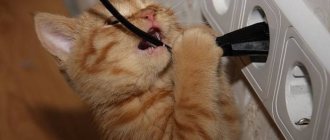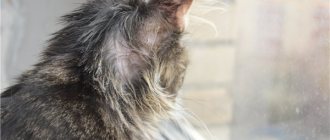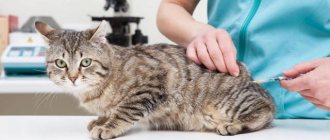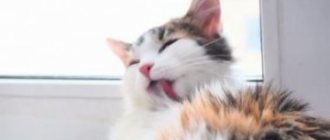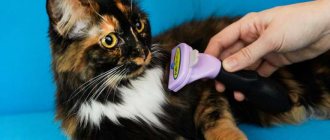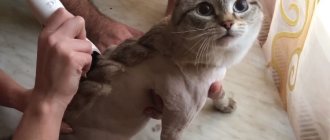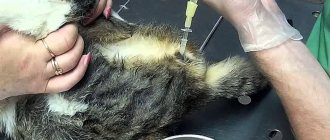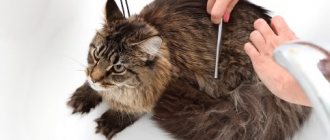He bites his tail because there are fleas or other diseases
One of the most common reasons why your cat bites her tail is because she simply has fleas.
The itching caused by these animals causes the cat to chase and bite its tail to relieve discomfort.
But this situation can occur not only from fleas, but also from itching caused by other reasons, such
as:
- Problems in the anus
- Food allergies
- Arthritis
- Intestinal parasites
- etc.
Either way, it is important that you go to a veterinarian to have him examined and determine if the cause of his behavior is caused by an external agent that may be causing this itching.
Boredom or stress may also be a cause
But not only for health reasons, your cat is biting its tail,
but psychological factors can also intervene to cause the animal to ultimately behave this way.
A cat may end up biting its tail because it is bored
. If you find that she begins to chase him at certain times of the day, it is best to start playing with her to avoid injury. You can play by buying a special toy for these animals or creating them yourself using materials you have at home.
Another reason is that the animal is stressed
and hence begins to bite the tail as a compulsive act. It is important that you stop and relax it, so that you can live calmly and without worry. The cause of stress for a cat can be many factors: a change of home, the arrival of a new member in the family (both animal and new person), noise, etc. It is best if you adapt the place in your home so that the animal can be relaxed and calm, and you will see how gradually it stops biting its tail.
Methods to combat the symptom
If this is a manifestation of an allergic reaction, then the second step will be to search for the allergen. This could be household chemicals or new food. And sometimes the symptom is provoked by a cumulative effect. For several years the cat’s body did not react to the irritant, and only now the first signs appeared. Once the culprit is identified, it should be eliminated immediately.
With hyperesthesia, everything is a little more complicated. The disease is incurable, but the condition can be blocked. For this purpose, antidepressants, sedatives and even anticonvulsants are prescribed. It is also wise to seek the help of a cat behavioral specialist. He will conduct observation and identify what factors have a detrimental effect on the pet. Then make a list of changes that will help normalize the animal’s condition. It may include:
- A safe environment - the absence of hidden conflicts between the pet and other inhabitants of the house.
- Enriched environment – cats often experience stress due to limited territory. This gives them a feeling of insecurity. Therefore, it is important to provide your pet with the opportunity to climb to heights. It is advisable that he have a spare shelter located above human height. There should be food and drink there.
- Playing together with their owner - cats are very sociable. Therefore, any attention is good for them. You can use special toys or just start a fun romp. Even regular brushing or other physical contact will help the animal relieve stress.
If you notice that your cat is chewing its tail, first conduct a full medical examination by contacting a competent veterinarian. And if the reason is still of an emotional nature, look for a good zoopsychologist. Timely identification of the problem and the correct course of treatment is the key to the health and full life of your pet.
The reasons for this behavior can be very different. First of all, it is necessary to exclude medical problems, and secondly, psychological ones. Medical reasons for this behavior may include arthritis, abscesses, cancer, spinal problems, injuries, allergic reactions, eczema, fungi and other diseases that cause itching or pain in the tail.
Cats play to chase each other's tail
Another reason why an animal has the habit of chasing and biting its tail is that it is simply playing
. Consider that they are generally calm and usually sleep many hours a day, so from time to time, at the moment when they want to be activated, they may start playing with anything: fluff, paper and even their own tail.
In this case, you don't need to deprive him because he only wants to play. Although you can pay more attention and play with him so as not to hurt him.
Why do cats chew their own tail?
Ectoparasites
The tail is a favorite habitat for fleas, lice, lice, Heyletiella skin mites, and subcutaneous Notoedrus. The affected surface itches, so the cat chews it. The situation is aggravated by the attached micromycetes and bacteria. The cat violently bites its tail; cases of amputation of the tip are known.
Infection with external parasites and subcutaneous mites is characterized by the following symptoms, which spread to other areas of the body:
- papules with a red border are formed;
- itchy fibrous nodules form;
- patches of baldness appear;
- upon examination, fast-moving insects and black dots are discovered - their excrement, consisting of semi-digested red blood cells;
- the cat becomes aggressive, constantly meows, tries to bite;
- grains of dandruff appear.
The cause of the pathological condition is identified by clinical signs and medical history. Find out whether the cat owner regularly uses insecticidal and acaricidal preparations. Treatment consists of expelling ectoparasites using an antiparasitic spray.
Eggs of lice eaters and fleas are immune to poisons, so treatment is carried out twice with an interval of 8-10 days. If Notoedrosis is diagnosed, or the itching persists after two treatments, the application of the drug is continued until the pathological signs are eliminated.
To speed up healing, external agents with antimicrobial and antifungal effects and vitamin preparations are prescribed.
Be sure to read:
The cat has black dots on the chin under the fur: what are they, causes, medications and folk remedies
The best option is to use therapeutic food for cats with skin diseases. Prevention consists of regular use of insecto-acaricidal drops Spot-on, which destroy ectoparasites, subcutaneous mites and helminths.
Feed allergy
Allergens supplied with food gradually accumulate in the body. The development of the disease is facilitated by the combination of ready-made food with natural food and treats with human food. Eating food containing the irritant for several months results in itchy dermatitis.
In addition to tail chewing, food allergies are manifested by the following symptoms:
- a rash appears on the face and neck;
- the mouth smells bad;
- dandruff appears on the back and tail;
- Digestive disorders occur.
If a feed allergy is suspected, a feed mixture that does not contain irritants is selected. The best option is to switch to hypoallergenic veterinary food. To prevent food allergies, they use ready-made food of at least premium class.
Stress
The painful condition consists of overstrain of the nervous system under the influence of the following factors:
- moving;
- Exhibitions;
- boredom;
- the appearance of a competitor in the house - another cat, dog, newborn child;
- sudden change in diet;
- chronic diseases;
- allergies to medications and accessories.
To eliminate a stressful situation, use a distraction method or anti-stress medications. A bored cat needs increased attention from the owner, and in his absence, entertaining toys, climbing frames, and scratching posts.
An alternative is the use of sedative medications: Stop-stress, Vetspokoin; Fitex; Cat Baiyun.
To prevent stressful situations, an atmosphere of happiness is created in the apartment with the help of the drug Feliway. The best option is to plug in a device that looks like a fumigator and distributes pheromones that only the pet can sense.
Inflammation of the paraanal glands
Paired glands are located on the sides of the anus and are necessary for marking territory, attracting sexual partners, and scaring away large predators.
Stagnation of secretion leads to inflammation and occurs mainly in cats that do not have access to the street for the following reasons:
- obesity;
- adynamia;
- combination of natural products and ready-made food;
- congenital predisposition;
- chronic diseases;
- old age.
Be sure to read:
Sores on a cat’s neck that itch and hair fall out: normal or pathological, reasons, what to do
Normally, the glands are invisible, but when inflamed they itch, which prompts the cat to lick the affected area, chew its tail, and ride on its butt. Treatment consists of cleaning the anal glands. If the disease is advanced, surgery is necessary.
Prevention consists of rational feeding, prevention of obesity, and an active lifestyle for cats.
Seborrhea
Symptom of seborrhea - sebaceous tail
Seborrhea or disease of the sebaceous glands occurs under the influence of the following pathological factors:
- too dry indoor air during the heating season or extreme heat;
- congenital predisposition;
- frequent bathing with shampoos;
- cheyletiellosis;
- acne;
- diabetes;
- genitourinary diseases.
Treatment and prevention is to eliminate the causes of the disease. To wash the greasy tail, use a special antiseborrheic shampoo.
Attract attention
It is also possible that the animal has this behavior because it is jealous
the arrival of a new person in the house. Cats are very territorial and don't take change well, so if a child arrives or sees a new animal in your home, it's best to spend some time introducing yourself and letting your cat get used to this new presence.
In this sense, the animal will bite its tail only to attract attention
. Although they are very independent, the truth is that they place great importance on love and want to feel loved. Therefore, if they feel that you are paying attention to other members, they may act in this peculiar way.
